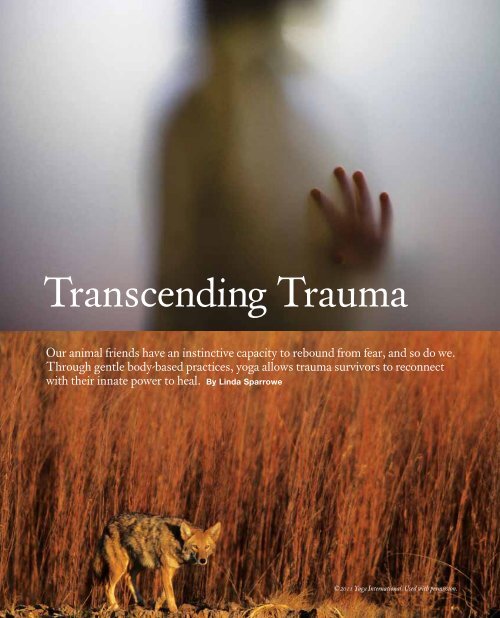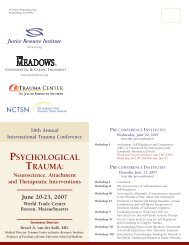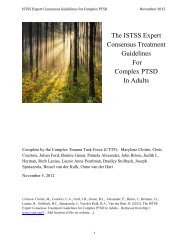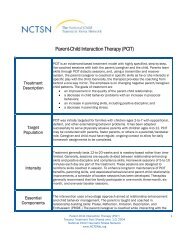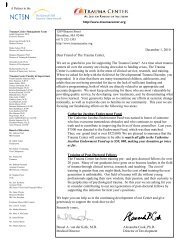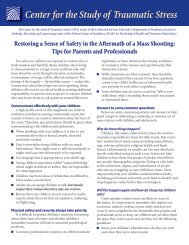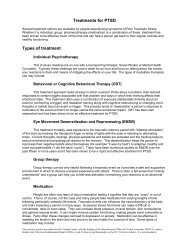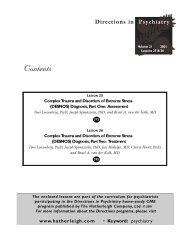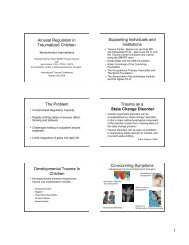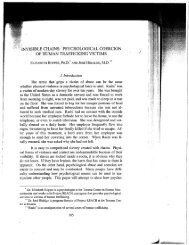Transcending Trauma - The Trauma Center
Transcending Trauma - The Trauma Center
Transcending Trauma - The Trauma Center
Create successful ePaper yourself
Turn your PDF publications into a flip-book with our unique Google optimized e-Paper software.
<strong>Transcending</strong> <strong>Trauma</strong><br />
Our animal friends have an instinctive capacity to rebound from fear, and so do we.<br />
Through gentle body-based practices, yoga allows trauma survivors to reconnect<br />
with their innate power to heal. By Linda Sparrowe<br />
Photo credit.<br />
48 yogainternational.com fall 2011<br />
©2011 Yoga International. Used with permission.
Elaine breathes slowly, in and out, for a few rounds of simple pranayama before she has to<br />
stop. Images too scary for her to describe race in and overwhelm her. After a few moments, with Jocelyn<br />
Jenkins, her therapist, sitting next to her, Elaine tries again. Several sessions later they move on<br />
to very basic, very slow sun salutations; she becomes aware of her muscles, noticing any resistance in<br />
her body, stopping when she gets too agitated.<br />
Although these postures and breathing exercises sound easy and<br />
soothing for most of us, they represent enormous progress for<br />
Elaine (not her real name), who cut herself off from any connection<br />
with her body or her emotions years ago. Jenkins remembers<br />
the first time she met her. Elaine was very agitated, in a constant<br />
state of hyper-arousal, “alert to every movement in the room, every<br />
sound, even the rise of my eyebrow,” Jenkins says. But when<br />
it came to talking about her emotions, Elaine shut down.<br />
Here’s why. As a young girl, Elaine was brutally raped.<br />
Unbelievably, no one in her family noticed—not even when she<br />
came to the dinner table covered from head to toe in bruises.<br />
Without anyone to guide her or help her make sense of<br />
what had happened, Elaine tried to rid herself of any residual<br />
sensations she felt—she binged and purged, used laxatives, and<br />
finally severely restricted her calories in an attempt to numb the<br />
pain, be invisible, and “yet at the same time,” Jenkins told me,<br />
“get someone to notice.” But no one did. Elaine felt alone and<br />
abandoned by the people she thought would protect her. By<br />
the time she checked into the Eating Recovery <strong>Center</strong> outside<br />
of Denver, Colorado, where Jenkins met (and noticed) her, she<br />
had a history of unsavory relationships with men, self-destructive<br />
behaviors, and no idea how to move forward.<br />
Elaine is a survivor of childhood trauma, and her inability<br />
to control her emotions, trust her body, or form meaningful<br />
and loving relationships is a common cluster of side effects<br />
associated with complex post-traumatic stress disorder (complex<br />
PTSD), according to Judith Herman, professor of clinical<br />
psychiatry at Harvard and author of <strong>Trauma</strong> and Recovery,<br />
fall 2011 yogainternational.com 49
who coined the term. This particularly<br />
insidious form of PTSD affects those<br />
who suffer from chronic childhood<br />
abuse. While we often think of PTSD<br />
as the intense and unexplained symptoms<br />
military men and women experience<br />
coming home from battle, this<br />
anxiety disorder can take many forms<br />
and touch a much wider population.<br />
Being raped, getting hit by a car, witnessing<br />
a violent crime, being in a war<br />
zone, losing your best friend to cancer,<br />
or even being scared of the possibility of<br />
something bad happening can all contribute<br />
to PTSD. How you deal with<br />
how you feel in the aftermath of such<br />
events determines the level of trauma<br />
that gets lodged in your cells.<br />
Yoga can make a big difference for<br />
trauma survivors like Elaine, and we<br />
are beginning to see more research that<br />
backs up her experience. A three-year<br />
NIH–funded yoga and trauma study<br />
conducted at the <strong>Trauma</strong> <strong>Center</strong> at<br />
Justice Resource Institute in Brookline,<br />
Massachusetts, with women who have<br />
treatment-resistant complex PTSD, has<br />
shown promising results. Bessel van<br />
der Kolk, MD, the study’s principal investigator,<br />
and his colleagues presented<br />
preliminary findings at the 2010 International<br />
Society for <strong>Trauma</strong>tic Stress Studies<br />
conference in Montreal last November.<br />
Initial study results revealed that<br />
participation in trauma-informed gentle<br />
yoga leads to a significant reduction<br />
(over 30 percent) in symptoms of posttraumatic<br />
stress, including fewer intrusive<br />
thoughts and less dissociation from<br />
the body. By the end of the study (after<br />
only 10 weeks of yoga) several women in<br />
the yoga group no longer met diagnostic<br />
criteria for PTSD. Other smaller studies<br />
show yoga increases heart rate variability<br />
(HRV), a measure of how robust the<br />
brain’s arousal systems are. It appears<br />
that traumatized people have unusually<br />
low HRV, says van der Kolk—who is<br />
also founder and medical director of the<br />
<strong>Trauma</strong> <strong>Center</strong>—which could explain<br />
why they are “so reactive to minor<br />
stresses and so prone to develop a variety<br />
of physical illnesses.” Yoga’s ability<br />
to touch us on every level of our being—<br />
physical, mental, emotional, and spiritual—makes<br />
it a powerful and effective<br />
means for trauma victims to reinhabit<br />
their bodies safely, calm their minds, experience<br />
emotions directly, and begin to<br />
feel a sense of strength and control.<br />
All Talked Out<br />
Most experts agree that trauma’s effects<br />
live in the body—and that’s why<br />
yoga works. Evidence suggests that<br />
people like Elaine respond best to<br />
body-based therapies, coupled with<br />
psychotherapy, because traditional<br />
“talk” therapy alone can dredge up old<br />
memories and reignite the pain all over<br />
again. And, while the mind may spend<br />
countless hours reliving the event and<br />
retelling the tale, it cannot undo the<br />
effects of what happened—the terror,<br />
rage, helplessness, and depression that<br />
then manifest in the body. According<br />
to van der Kolk, trauma is not the story<br />
we tell about the violence we endured<br />
or the horrible accident we witnessed;<br />
it’s not even the event itself. Instead<br />
it’s the stuff we can’t let go of—what<br />
van der Kolk calls the “residue of imprints”<br />
(and yogis call samskaras) that<br />
gets left behind in our neurophysiology<br />
(our sensory and hormonal systems).<br />
Van der Kolk, the author of numerous<br />
articles and studies on how trauma affects<br />
the brain, says that traumatized<br />
people are “terrified of the sensations<br />
in their own bodies,” so it’s imperative<br />
that they get some sort of body-based<br />
therapy to feel safe again, he says, and<br />
learn to care for themselves.<br />
Unresolved “issues in our tissues”<br />
manifest physically as migraines, nervous<br />
tics, clenched muscles in the neck,<br />
shoulders, and jaw, a sunken chest, or a<br />
heavy heart. Left unresolved, they can<br />
exact an even heavier toll in the form of<br />
heart disease, diabetes, panic attacks,<br />
ADHD in children, fibromyalgia, irritable<br />
bowel syndrome, and a host of<br />
autoimmune disorders.<br />
On a Physical Plane<br />
Before a trauma survivor like Elaine can<br />
let go of any residue or feel any physical<br />
sensations, she needs to spend time getting<br />
to know her body—a little bit at a<br />
time. Dana Moore, a Santa Fe–based<br />
psychotherapist and Kripalu Yoga<br />
teacher who specializes in trauma therapy,<br />
told me adults who were neglected<br />
or abused as children “probably had no<br />
healthy way of learning about their bodies.”<br />
Most of them have neither a strong<br />
sense of self nor a keen sense of the con-<br />
Previous spread: Left top: DonSmith / Alamy; Left bottom: Bill Coster WF / Alamy; Right: John Terence Turner / Alamy; This spread: Jeff Feverston / Getty Images<br />
50 yogainternational.com fall 2011
nection between the internal and the external.<br />
In his sessions, Moore likes to invite students<br />
to pendulate between movement and<br />
rest, between interoception (sensations in the<br />
body) and exteroception (stimuli outside the<br />
body). For example, he might guide trauma<br />
victims through an exploration of the left<br />
hand, noticing every muscle and movement,<br />
and then ask them to stop, rest, and feel. And<br />
then ask them to bring their attention to their<br />
ears, noticing any sounds they hear. An exercise<br />
like this reminds them that they can feel<br />
something deeply and shift the focus, coming<br />
out of discomfort, anytime they want.<br />
Moving from one asana to another, slowly<br />
and deliberately, encourages students to stay<br />
with sensation and notice what’s happening<br />
in their bodies, and to approach each movement<br />
with a sense of curiosity. <strong>The</strong> simplest<br />
of poses (standing or sitting in a chair) can<br />
produce profound results. Just feeling his feet<br />
on the floor for the very first time gave one<br />
agitated survivor a sense of balance, stability,<br />
and safety. For Elaine, who dissociated from<br />
her body and felt numb, doing gentle supported<br />
backbends began to wake up her body<br />
and get the blood flowing. Building a strong,<br />
capable body goes a long way toward developing<br />
a strong, centered mind.<br />
No matter what poses survivors choose to<br />
do—or how much they experiment with the<br />
breathing exercises—they benefit from knowing<br />
that each exercise comes to an end, that<br />
they won’t get stuck in emotional overwhelm.<br />
A pose might feel uncomfortable, a round of<br />
pranayama might bring up feelings they would<br />
much rather stuff back down, but the sensations<br />
are temporary, only around until the next<br />
posture or the next exhalation. >><br />
Teaching Yoga to <strong>Trauma</strong> Survivors<br />
David Emerson, co-author of Overcoming <strong>Trauma</strong> through Yoga, says to<br />
be a successful trauma-sensitive yoga teacher, you should be willing to examine<br />
your prior yoga training with an open mind in light of current understanding<br />
of trauma and PTSD; take feedback from students; and avoid physical assists.<br />
It is important to be highly competent in order to create a sense of safety for<br />
students, while not acting as the “expert,” so that students can find their own<br />
way within safe parameters.<br />
Teacher Trainings<br />
1. <strong>Trauma</strong>-Sensitive Yoga<br />
<strong>The</strong> <strong>Trauma</strong> <strong>Center</strong> at Justice Resource Institute; David Emerson, director.<br />
Forty-hour training offered in the fall and a weekend training offered in<br />
the spring at Kripalu Yoga <strong>Center</strong>, Lenox, Massachusetts. traumacenter.org<br />
2. Integrative Restoration Institute<br />
Richard Miller, PhD, director. Three levels of iRest yoga nidra training offered<br />
throughout the year at various locations. irest.us/programs/trainings<br />
3. Warriors at Ease<br />
Robin D. Carnes, director. Advanced trainings and certification for teaching<br />
yoga in military settings; three levels, including one teleconference series, offered<br />
throughout the year. warriorsatease.com<br />
4. Integrated Movement <strong>The</strong>rapy<br />
Molly Lannon Kenny, director. Trainings and certification program combining<br />
yoga and conventional neurophysiology offered throughout the year<br />
at the Samarya <strong>Center</strong> in Seattle, Washington. samaryacenter.org<br />
5. Breath-Body-Mind Training for <strong>Trauma</strong><br />
Richard P. Brown, MD, and Patricia L. Gerbarg, MD, co-directors.<br />
Five-day trainings in meditation and breathing practices. haveahealthy<br />
mind.com<br />
Three-day weekend trainings also available through Street Yoga, Portland,<br />
Oregon (streetyoga.org); Embodyoga’s Veteran’s Yoga Project, Newington,<br />
Connecticut (newingtonyogacenter.com); Teaching Yoga to At-Risk<br />
Youth and Adults, YogaWorks, New York (halakhouri.com). —L.S.<br />
fall 2011 yogainternational.com 51
Many therapists and experts on<br />
yoga for trauma use body scans to help<br />
survivors find a degree of safety in their<br />
bodies—moving up through the body<br />
one muscle or body part at a time.<br />
Karen Soltes runs a program at the<br />
Washington, DC, VA Medical <strong>Center</strong><br />
teaching iRest—a more accessible form<br />
of yoga nidra, developed by Richard<br />
Miller, PhD, director of the Integrative<br />
Restoration Institute—to veterans with<br />
PTSD. She says body scans can give<br />
trauma survivors “safe passage into the<br />
body, where hopefully they’ll find some<br />
degree of peace and relaxation.” Peter<br />
A. Levine, PhD, author of In an Unspoken<br />
Voice, calls this going “underneath<br />
overwhelming emotions” and tapping<br />
into physical sensation. Many survivors<br />
report that they are much more able to<br />
tolerate intense emotions without being<br />
swept away by them when they focus on<br />
the underlying sensation in their legs,<br />
bellies, chest, or shoulders. As with all<br />
yoga practices, survivors are encouraged<br />
to stay with the sensation for as long as<br />
they choose, and stop when they start to<br />
get agitated or frightened.<br />
According to van der Kolk, Western<br />
medicine doesn’t give us many tools to<br />
“master our own physiology,” so too<br />
many times trauma survivors end up<br />
self-medicating with drugs and alcohol<br />
as well as prescription drugs. Pranayama<br />
can have an energizing or calming effect<br />
on the nervous system, he says,<br />
and quiet the brain. Soltes adds that the<br />
breath can keep survivors in the body.<br />
Gentle pranayama that emphasizes<br />
the exhalation, she says, works well for<br />
those who chronically hold their breath<br />
or feel agitated. Alternately, focusing on<br />
the inhalation can help those collapsed<br />
in depression or dissociation, especially<br />
when paired with movements like modified<br />
sun salutations.<br />
Your Brain on <strong>Trauma</strong><br />
So how exactly do yoga asanas and<br />
pranayama quell agitation or energize<br />
Healing Meditation Practice<br />
<strong>The</strong> following mantra meditation, as taught by master teacher Sri Dharma<br />
Mittra, gives the mind an anchor to return to when sensations or memories surface.<br />
Preparation<br />
Sit in a comfortable cross-legged position (or on a chair with your feet<br />
flat on the floor) and your hands resting comfortably on your thighs,<br />
with palms facing up.<br />
Coordination<br />
Synchronize the breath with the following syllables and mudras (hand gestures).<br />
Inhale to the count of four as you slowly and gently close your fingers<br />
in toward your palms, keeping thumbs soft, while silently saying the first<br />
syllable. Exhale to the count of four as you slowly and gently open your palms<br />
while silently intoning the second syllable, and so on.<br />
HUM (inhale)…SA (exhale)…SO (inhale)…HUM (exhale)<br />
SO (inhale)…HUM (exhale)…HUM (inhale)…SA (exhale)<br />
SO (inhale)…HUM (exhale)…HUM (inhale)…SA (exhale)<br />
HUM (inhale)….SA (exhale)…SO (inhale)…HUM (exhale)<br />
Repeat the pattern for several rounds. —L.S.<br />
For more on Sri Dharma Mittra, visit dharmayogacenter.com.<br />
a collapsed spirit? Before we talk more<br />
specifics, a little neurophysiology lesson<br />
is in order. Under normal conditions,<br />
the body is hardwired to protect us from<br />
danger or stressful situations; trouble<br />
ensues when its process is interrupted.<br />
<strong>The</strong> best way to understand the human<br />
response is to look at animals in the<br />
wild. Sounds a bit far-fetched, perhaps,<br />
but Levine contends that our nervous<br />
system has a lot more in common with<br />
our four-hoofed brethren than we might<br />
think. A group of deer grazing in a meadow,<br />
for example, may appear happygo-lucky,<br />
but they are continually on the<br />
lookout for predators lurking in the forest<br />
nearby. <strong>The</strong> very first thing the deer do<br />
when they perceive danger is to stop, stay<br />
very still, and listen. This hyper-vigilant<br />
stage of arrest activates the sympathetic<br />
nervous system (in charge of the fight-orflight<br />
response to danger) and serves two<br />
purposes. One, it allows them to figure<br />
out what the threat might be and where<br />
it’s coming from (a smell in the air or a<br />
rustle in the bushes), and two, it helps<br />
them be more invisible to a predator.<br />
<strong>The</strong> moment the deer feel a predator’s<br />
presence, they take flight, running<br />
to safety as fast as they can. If one falters<br />
and the coyote catches up to her, her<br />
first instinct is to rise up and fight back.<br />
If that fails, and she gets caught, she<br />
freezes, her muscles stiffening against<br />
the assault, and then folds, going limp<br />
and numb—helpless to protect herself.<br />
<strong>The</strong> fold or collapse state of hypoarousal<br />
activates the parasympathetic<br />
nervous system, shutting down the<br />
body’s defenses, allowing her to dissociate<br />
from the event, and preventing her<br />
from feeling too much pain. If she’s able<br />
to fool her predator and race to safety,<br />
she’ll tremble, literally shaking off the<br />
event, and return to the meadow in time<br />
for the next meal. While her brain registers<br />
the event and files away a “do not go<br />
near those bushes on the right” message,<br />
her ordeal is over and done with.<br />
<strong>The</strong> human nervous system works<br />
much the same way. When we perceive<br />
52 yogainternational.com fall 2011
NO MATTER WHAT POSES SURVIVORS CHOOSE TO DO, THEY BENEFIT<br />
FROM KNOWING THAT EACH EXERCISE COMES TO AN END, THAT THEY<br />
WON’T GET STUCK IN EMOTIONAL OVERWHELM.<br />
danger, the sympathetic nervous system<br />
and the hypothalamic-pituitary-adrenal<br />
(HPA) axis mobilize the body’s fight-orflight<br />
resources. Stress hormones pour<br />
into the bloodstream so we can react<br />
appropriately. <strong>The</strong>y increase our heart<br />
rate, divert blood into our large muscle<br />
groups (arms and legs), and speed up<br />
reaction time. An increase in cortisol releases<br />
sugar as fuel into the bloodstream<br />
so we can think and move faster. In the<br />
meantime, the HPA axis communicates<br />
with the rest of the body, instructing the<br />
digestive, reproductive, and immune<br />
systems to slow down and wait out the<br />
danger. All this activity creates a state<br />
of hyper-arousal and fuels the emotions<br />
and actions we need to first gain sensory<br />
information and then either fight an aggressor<br />
(anger) or, if need be, flee the<br />
scene to safety (anxiety and fear). Just<br />
like our animal friends, humans can also<br />
experience complete collapse, or hypoarousal—when<br />
the parasympathetic nervous<br />
system activates to help us survive<br />
horrific acts of violence. Both the alert<br />
and the fold states are designed to be<br />
short-lived, functioning to keep us alive<br />
and safe from harm.<br />
As we can see, our autonomic nervous<br />
system was designed to be on the lookout<br />
for danger and keep us safe. Problems<br />
arise when the pain and traumatic residue,<br />
or samskara, remains in the body<br />
long after the event is over and the brain<br />
cannot discriminate between what is in<br />
the past and what is a real, present threat.<br />
<strong>The</strong> body’s posture (rigid or collapsed)<br />
continues to signal danger, so the nervous<br />
system goes in search of the perpetrator,<br />
assigning blame wherever it can. Levine<br />
says, “If frightening sensations are not<br />
given the time and attention they need<br />
to move through the body and resolve or<br />
dissolve, the individual will continue to be<br />
gripped by fear.”<br />
According to David Emerson, co-author<br />
of Overcoming <strong>Trauma</strong> through Yoga<br />
and director of the <strong>Trauma</strong> <strong>Center</strong>’s<br />
yoga program, people who have experienced<br />
chronic or repeated trauma “find<br />
themselves alternating between being<br />
highly sensitized and easily triggered,<br />
and feeling numb or disconnected from<br />
themselves and other people.”<br />
Calming the Waters<br />
In addition to the recently concluded<br />
NIH study, other studies and plenty of<br />
anecdotal evidence support the claim<br />
that yoga mitigates the fight-or-flight<br />
response through a combination of active<br />
asanas, pranayama (with particular<br />
emphasis on the exhalation), and deep<br />
relaxation. It does this by decreasing<br />
the sympathetic nervous system’s<br />
reactive response and increasing the<br />
parasympathetic relaxation response.<br />
Jay P., an Air Force vet from the Boston<br />
area, who experienced a brutal assault<br />
when he was stationed overseas in the<br />
early ’80s—too horrible for him even to<br />
describe—shares a story that perfectly<br />
demonstrates yoga’s calming effect.<br />
One manifestation of Jay’s trauma is<br />
acute anxiety, which gets triggered when<br />
he’s in a crowd of people. After a particularly<br />
difficult therapy session, he says, “I<br />
was feeling a lot worse than when I came<br />
in.” He got to the metro station in Boston,<br />
right in the middle of rush hour. His anxiety<br />
built as the crowd grew bigger; at one<br />
point, he says, “I felt like, ‘I don’t think<br />
I can do this.’” Feeling quite agitated,<br />
he turned around to leave, and then he<br />
saw a woman standing nearby holding a<br />
little child. “I put my hand on my belly<br />
and started to breathe—really focusing<br />
and paying attention to my breathing as<br />
I looked at the little kid and her mom.”<br />
Suddenly the crowd and Jay’s anxiety<br />
seemed to dissipate—everything felt more<br />
manageable. “I had put myself into a<br />
shavasana-type pose with a sweet little kid<br />
in front of me,” he says, and it worked.<br />
Re-energizing the Body<br />
Less well known is yoga’s ability to<br />
put the brakes on an overly active parasympathetic<br />
nervous system (PNS).<br />
Recognized for its role in the relaxation<br />
response, the PNS can also get stuck<br />
on unhealthy overdrive. As our animal<br />
friends demonstrated, the freeze-andfold<br />
response involves shutting down<br />
the body’s responses and lowering blood<br />
pressure and heart rate, all of which<br />
allows a victim to dissociate from the<br />
traumatic event, and prevents him from<br />
feeling too much pain. Unfortunately for<br />
trauma survivors, long after the event has<br />
passed, they may still feel numb and depressed,<br />
constantly tired, and completely<br />
dissociated from their feelings. Levine<br />
says chronic immobility paralyzes a<br />
trauma victim, and fear of unleashing her<br />
feelings deepens her sense of paralysis.<br />
It’s important, he says, for survivors to<br />
learn to disentangle the fear and helplessness<br />
from their immobility. Elizabeth<br />
Hopper, PhD, co-author of Overcoming<br />
<strong>Trauma</strong> through Yoga, tells the story of<br />
Seleni to illustrate how yoga can help.<br />
Seleni (again a pseudonym), who<br />
grew up in an African country that has<br />
experienced a great deal of violence, was<br />
trafficked into domestic servitude in the<br />
United States. Scooped up into the arms<br />
of Project Reach, a program that serves<br />
survivors of human trafficking, Seleni<br />
learned that she would be required to<br />
repeatedly tell (and hence relive) her<br />
story—to prosecutors, lawyers, judges,<br />
and therapists—in hopes of identifying<br />
and eventually prosecuting her abusers.<br />
Hopper, program director of Project<br />
Reach, says she sat with Seleni, watching<br />
and listening as she (continues on page 89)<br />
fall 2011 yogainternational.com 53
<strong>Transcending</strong> <strong>Trauma</strong><br />
(continued from page 53)<br />
recounted the horrific details of her plight. At one point, Hopper<br />
noticed that Seleni’s body began to sag forward, growing heavier<br />
and weaker until it gave way, and her head and upper body collapsed<br />
on the desk in front of her. She told Hopper that she shuts<br />
down this way when she has to talk about her ordeal; and when<br />
that happens, she knows she won’t be able sleep that night.<br />
Instead of continuing with the story, Hopper asked Seleni<br />
to stand up. <strong>The</strong>y breathed together—emphasizing the inhalation—gently<br />
energizing Seleni’s body and activating her<br />
sympathetic nervous system. In a slow, rhythmic way, Hopper<br />
led Seleni through a dynamic mountain pose, encouraging her<br />
to move between a posture in which she collapses (shoulders<br />
hunched forward, neck and head bowed) and one in which she<br />
lifts her chest, elongates her spine, and raises her head up. Seleni’s<br />
inhalation deepened and she began to coordinate arm movements<br />
with the rise and fall of her breath. When she returned to<br />
her chair, Seleni sat up straighter and her face brightened. She<br />
even shared a few spiritual songs from her tradition that always<br />
made her feel better.<br />
Engaging the Mind<br />
Meditation can also help trauma victims to bring their nervous<br />
system back into balance. But sitting in silent meditation, with<br />
just their thoughts to keep them company, can be terrifying, according<br />
to van der Kolk. He says trauma-sensitive people “have<br />
their sense of time thrown off and think something will last<br />
forever.” So he suggests those with PTSD get more comfortable<br />
with postures and breath work and learn relaxation techniques before<br />
moving on to meditation. Mantra meditation and yoga nidra<br />
provide two alternatives to following one’s thoughts in silence.<br />
Using a mantra (see “Healing Meditation Practice” on page 52)<br />
gives the mind an anchor, a companion on the journey inward,<br />
something to return to as memories and sensations surface and<br />
dissolve. Yoga nidra or Richard Miller’s iRest practice helps<br />
them stay present to what’s going on—feeling the energy of the<br />
body, and exploring sensations without judgment or attachment.<br />
While no one I spoke with believes yoga alone has the power<br />
to heal the pain trauma survivors endure, every single survivor,<br />
teacher, and expert wholeheartedly believes yoga provides a powerful<br />
ally on the journey home, and allows survivors—many for<br />
the very first time—to create a loving and nurturing relationship<br />
with their bodies. We can’t predict or control what the future<br />
holds, nor can we change what the past has dealt, but we can<br />
learn to care deeply about ourselves and to embrace the present. n<br />
Contributing editor Linda Sparrowe is the author of several books, including A<br />
Woman’s Book of Yoga and Health with Patricia Walden. She co-leads yoga<br />
and meditation retreats for women with cancer at Shambhala Mountain <strong>Center</strong><br />
and Kripalu <strong>Center</strong> for Yoga and Health.<br />
fall 2011 yogainternational.com 89


